
Balik Pulau durians are essential for any durian lover. Touted as the king of fruits, this thorny seasonal treat not only gets us craving for its custardy flesh, but it has inspired arts and books, too. Thomas Powell, a Penang-based British artist, has a work entitled The King and the Queen, in which Queen Victoria is holding a durian instead of the traditional orb. American Lindsay Gasik's love for durians has led her to write The Durian Tourist’s Guide to Penang, in which she writes:
“It’s all the things that make eating durian in Penang different from eating durian anywhere else in the world. It’s the soil and the weather, the way the farmer takes care of his trees, and the style and techniques that durian sellers use to select and present the durian to his customers. It encompasses the whole experience of farm-to-table-to-mouth.” [1]
Durians from Penang, especially Balik Pulau, are commonly perceived to be some of the highest quality in Malaysia. So, why are Balik Pulau durians so good?

Crazy for Balik Pulau durians! Photo credit: hazlyhashim (Instagram)
Decades-Old Trees
Balik Pulau, Penang Island’s hinterland beyond the hills, is where nutmegs and cloves were once cultivated in the mid-19th century. By the early 1900s, rubber began to displace these two earlier crops. However, with the decline of world rubber prices in the 1960s, the Hakka farmers in Balik Pulau turned to cultivating a variety of fruits, including durians. [2]
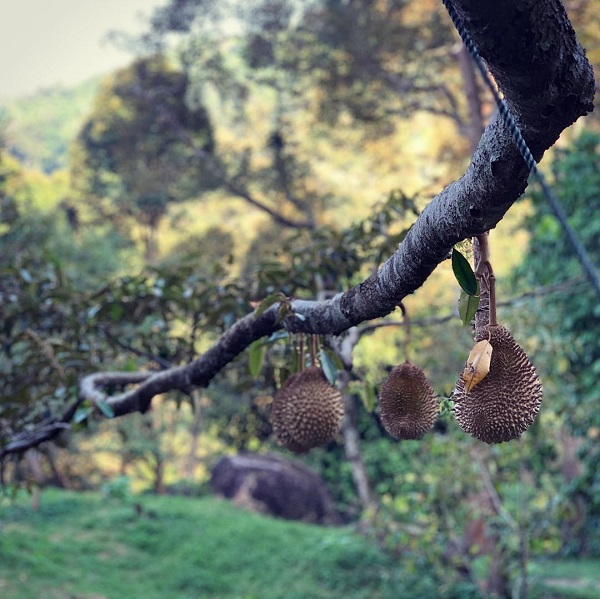
Photo credit: sg.farmforfood (Instagram)
While six-year-old trees begin to yield fruits, it is older trees that produce the best-tasting fruits. "Grafted durians, as the stock from the graft is taken from a matured tree, usually takes 20 years onwards for the flavours to develop fully. But for those planted by seed, the older the tree, the more enhanced the flavours!" says Green Acres Orchard & Ecolodge owner Eric Chong.
Typically, the trees in Balik Pulau are planted either by direct seeding or grafting method. Grafting is a technique whereby tissues of plants are joined so as to continue their growth together. In essence, fruits from grafted trees are durian ‘clones’ such as Musang King, Ang Hay (Red Prawn) and other premium durians. Those planted by direct seeding are referred to as durian kampung (wild durians).
Chong also opines that due to minor differences in weather patterns every year, even durians from the same tree taste different. To determine the best durian quality, Chong places his trust on the farm's furry friends — squirrels!
"The best indicator of durian quality is squirrels. They are brand blind. They have the keenest smell, and they literally smell every durian within their roaming area and settle for their favorites.
"If they consistently eat from that particular tree, you can bet that that'll be the most aromatic with the biggest range of taste,” says Chong.
Straight from the Source
At Balik Pulau, there is a farm to cater to each durian lover’s taste, from hybrid to organic to the good old kampung durian. Although one can debate about which type of durian is the best tasting, it remains indisputable that Balik Pulau is the place to savour the freshest durians in Penang.
“Have you eaten durian in a busy city, where durian is faraway from its source? It’s not the same as eating durians in Balik Pulau – even if you’re getting your fix at a roadside stall. It’s the special connection with nature and the simpleness of village life that makes eating durians in Balik Pulau so profound,” says Kumar Shukor, the owner of Penang International Airport-based Vagabond Rent-a-Car & Tours.
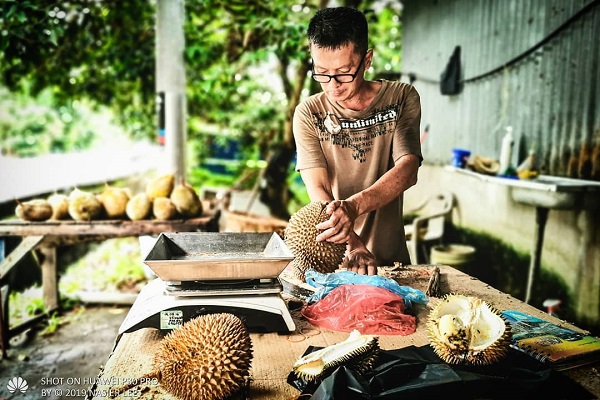
A roadside durian seller. Photo credit: nasierlee (Instagram)
For photo-video journalist Fitri Musa, staying at Bao Sheng Durian Farm in Balik Pulau is memorable. “Waking up to the view of fruit-bearing durian trees is breathtaking. I found myself anticipating the durian “thump”. It means that a durian has fallen somewhere nearby, and I can go and pick it up by myself,” he says.
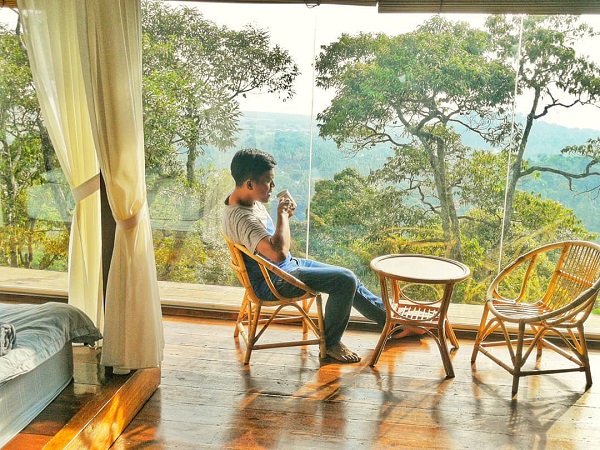
Photo credit: fitrimusa (Instagram)
“The best durians are the ones consumed fresh from the trees. That’s why my farm is open for visitors to stay and eat fresh durians,” says Bao Sheng Durian Farm owner Chang Teik Seng.
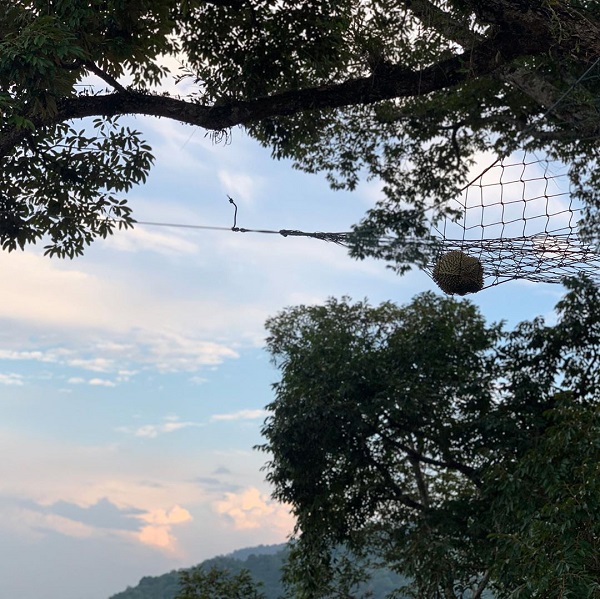
Photo credit: sg.farmforfood (Instagram)
Balik Pulau durians are harvested only when the fruits have ripened and fallen to the ground on their own accord. Here, durian farmers either attach wide nets or tie the durians to the tree. These methods keep farmers, workers, and visitors safe.
“The hillside in Balik Pulau is very steep, with a lot of big boulders and rocks. Without them, the durians will go tumbling down the hills at very high velocity. I have seen airborne durians hitting a rock and just launched into the air!” Gasik says.
The methods also keep the fruits from hitting the ground and bruising, thus extending a durian’s shelf life, contributing to the fruit's complex flavours and characteristics. Upon consuming a naturally harvested durian within hours, the flesh of the fruit is fragrant, tastes sweet, bitter or fermented, and it usually leaves a numbing sensation on one's tongue.
Variants
“Not only is Penang famous for high-quality durians, but [it] also preserved many unique types of durian found nowhere else in Malaysia. The chances are high that here you will taste something entirely new and unique,” Gasik writes in her book. [3]
There are many variants in the market which are native to Balik Pulau, from the sweet-tasting Hor Lor (Gourd) to the creamy Ang Hay. Other well-sought-after Balik Pulau durians are D53, Cheh Chee (Green Skin), Ang Bak (Red Yolk), Balik Pulau 604, and more.
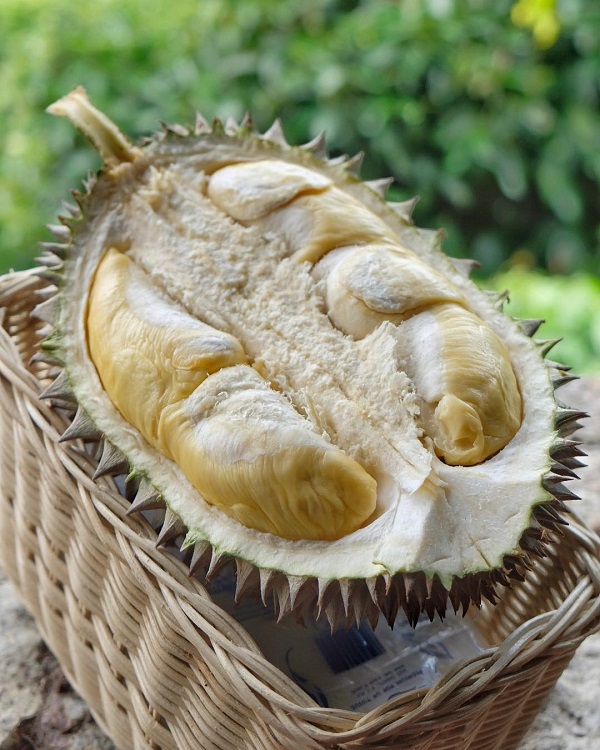
Green Skin durians are eclipsing Musang King’s popularity.
Photo credit: esther_etho (Instagram)
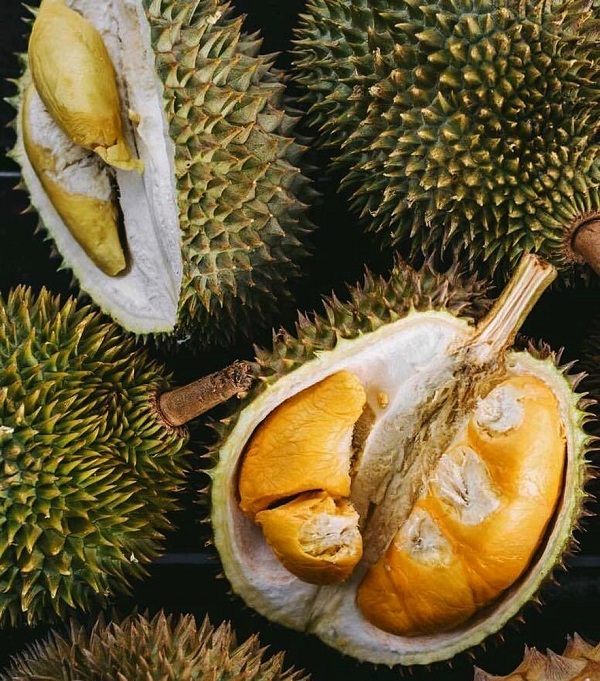
Musang King (bottom) is commonly available across the state. Photo credit: Rasasayangresort (Instagram)
“Local Penangites enjoy Ang Hay because it’s lemak (creamy), with a hint of bitterness,” says James Wong in an interview with the Pusat Internet Sungai Pinang YouTube channel. Wong owns the Wong Durian House in Sungai Pinang, Balik Pulau.
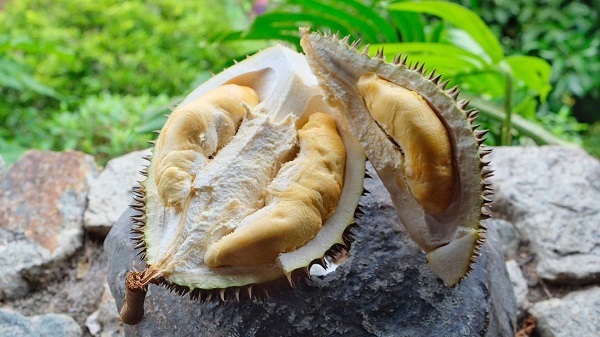
Ang Hay Durian. Photo Credit: esther_etho (Instagram)

Black Thorn durian is creamy, with an underlying richness, sweetness, and a slightly alcoholic aftertaste. Photo credit: bobamon.id (Instagram)
Another popular variant from Penang is Black Thorn or Ochee. Although the variant originated from Seberang Perai, Black Thorn has found its way into Balik Pulau farms, making it easy for durian lovers to taste the wide-ranging variety of durians Penang has to offer, without crossing the strait.
Durian kampung, considered to be the cheapest of all, is worth trying, too. Sellers stack them in baskets or spread them out in piles on the floor, but it does not mean they don’t taste good. They are just smaller in size and they are not premium durians like Black Thorn.
Something for Everyone
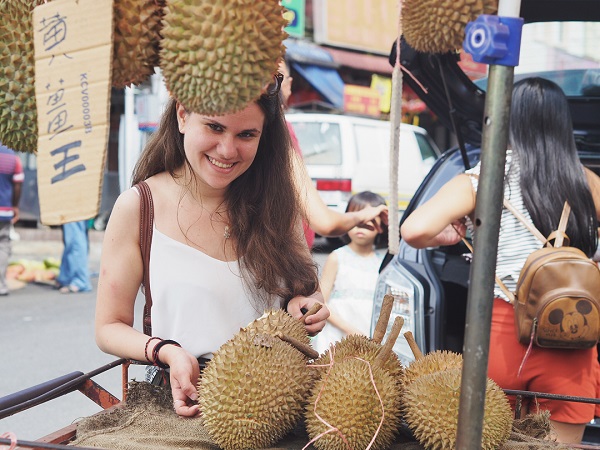
Photo credit: igoana88 (Instagram)
Durian is an acquired taste. With its strong aroma, creamy texture and sweet flesh, it is not what one expects of a fruit, and therefore can be quite jarring to the uninitiated. So when Oana Nenciulescu from the United Kingdom visited Penang in 2018, she was quite afraid to try it but was feeling rather adventurous. She was introduced to the Ang Hay durian, a common variant in Penang usually introduced to first timers, by a durian seller.
“Maybe I am strange but I really like durians! To me, it smells quite perfumed, and not really bad at all. The taste is so sweet, a cross between egg custard and mango. I couldn’t taste anything else apart from the sweetness! How come people hate it?” she wonders.
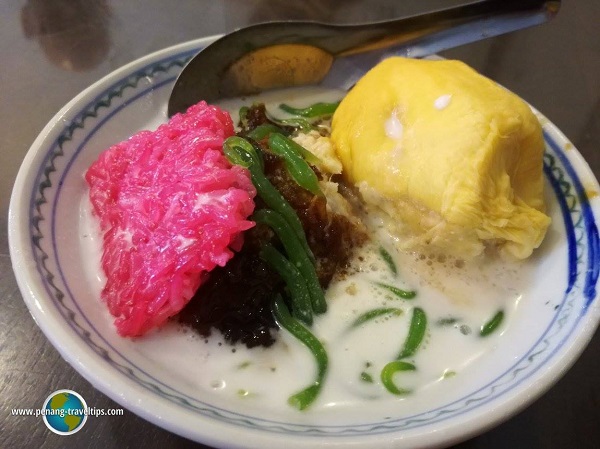
Durian cendol. Photo credit: Timothy Tye
Those who are looking for alternative ways to enjoy durians can give durian-based desserts a try instead, such as durian sticky rice, durian dodol, durian puff, durian ice cream, durian cendol and durian candy. These are normally available in durian stalls, wet markets, cafes, restaurants or pop-up stores in shopping malls.
Durian Delivery
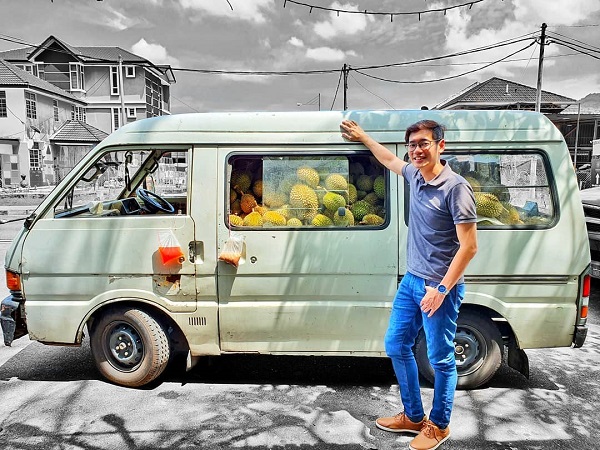
Photo credit: ig.penang (Instagram)
Penang durians are just a click (or a phone call) away. To place an order for delivery, contact the following vendors:
Vendor: Green Acres Orchard & Ecolodge
Contact: Book online or Whatsapp +6012 428 6368
Vendor: Bao Sheng Durian Farm
Contact: +6012 411 0600
Name: Lim's Brothers Durian Estate And Farm
Contact: +604 866 8551
Name: Wong Durian House
Contact: +6010 667 6755, +6016 400 8066
Vendor: Nutricient
Contact: +6012 498 0828
Vendor: 406 Dusun Durian Balik Pulau
Contact: +6012 427 7406
Vendor: Healthee Wealthee
Contact: +6012 597 1570
Vendor: Thian Sin Lim
Contact: +6017 470 8186, +6012 402 5578, +604 637 0823
Name: KK Lok
Contact: +6012 421 2239
Vendor: Great Fruit Agriculture
Contact: +6016 555 2808
Vendor: Durian Kaki
Contact: +6012 423 5520, +6019 589 8998
Vendor: Song Hai’s Durian
Contact: +6019 474 4439
Vendor: Teik Zai Durian (Cheng Hin 88 trading)
Contact: +6017 460 5039, +6012 987 5200 (Hin)
Vendor: Penang Ah Teik Durian
Contact: +6012 438 3881 (Teik), +6016 494 8404 (Alien), +6014 415 8579 (Ah Aun)
Vendor: Durian Canteen
Contact: via FaceBook Messenger
Vendor: Durian Balik Pulau Delivery Service
Contact: +6012 592 5655
Vendor: Suim Ping
Contact: +6013 432 2567
Vendor: Eddy Wong
Contact: +6019 541 1774
Vendor: Mark Wong
Contact: +6012 791 7736
Vendor: Albee Tan
Contact: via FaceBook Messenger
Vendor: Nick or Anddy Neo Stall 7509
Contact: +6016 471 3971 (Nick), +6011 123 87238 (Anddy)
Vendor: Chui
Contact: +6019 418 8997
Vendor: 8321槟城山中果王
Contact: +6016 434 4263, +6012 300 2091, +6012 486 0100
Vendor: Shan Cheng Durian Penang
Contact: +6010 274 8988
Vendor: 638浮罗榴莲Balik Pulau
Contact: +6017 983 8944
Vendor: Cally Ling
Contact: +6012 406 3889
Vendor: Casper Chuah
Contact: +6010 226 3710
Vendor: SK Lee
Contact: +6014 305 8686
Vendor: WY Chong Durian Specialist
Contact: +6017 460 5609, +6012 474 5178, +6012 586 9948
Vendor: Angie
Contact: via Wechat Angieteh901
Vendor: Pasar Pagi Bayan Baru
Contact: +6017 241 6287
Vendor: Tuff Fany
Contact: +6016 420 9435
Vendor: 691 Balik Pulau Durian
Contact: +6016 471 3186
Vendor: Sally Ong Ong
Contact: +6016 539 3097
[1], [3] Gasik L (2018) The Durian Tourist’s Guide to Penang, Malaysia. Hei Tu. E-Book. Available at: https://www.yearofthedurian.com/product/penang-durian-guide-book malaysiahttps://www.yearofthedurian.com/product/penang-durian-guide-book-malaysia
[2] Airriess, Christopher. (2020). Constructing durian terroir and geographical indications in Penang, Malaysia. Singapore Journal of Tropical Geography. 41. 6-22.